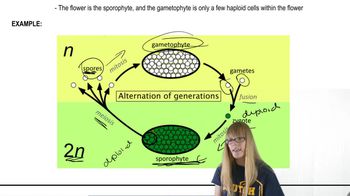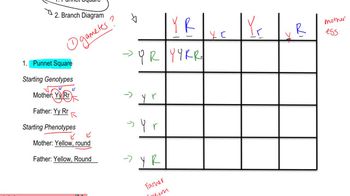Table of contents
- 1. Introduction to Genetics51m
- 2. Mendel's Laws of Inheritance3h 37m
- 3. Extensions to Mendelian Inheritance2h 41m
- 4. Genetic Mapping and Linkage2h 28m
- 5. Genetics of Bacteria and Viruses1h 21m
- 6. Chromosomal Variation1h 48m
- 7. DNA and Chromosome Structure56m
- 8. DNA Replication1h 10m
- 9. Mitosis and Meiosis1h 34m
- 10. Transcription1h 0m
- 11. Translation58m
- 12. Gene Regulation in Prokaryotes1h 19m
- 13. Gene Regulation in Eukaryotes44m
- 14. Genetic Control of Development44m
- 15. Genomes and Genomics1h 50m
- 16. Transposable Elements47m
- 17. Mutation, Repair, and Recombination1h 6m
- 18. Molecular Genetic Tools19m
- 19. Cancer Genetics29m
- 20. Quantitative Genetics1h 26m
- 21. Population Genetics50m
- 22. Evolutionary Genetics29m
2. Mendel's Laws of Inheritance
Probability and Genetics
Problem 6d
Textbook Question
Textbook QuestionConsider the cross AaBbCC×AABbCc.
How many different gamete genotypes can each organism produce?
 Verified Solution
Verified SolutionThis video solution was recommended by our tutors as helpful for the problem above
Video duration:
2mPlay a video:
Was this helpful?
Key Concepts
Here are the essential concepts you must grasp in order to answer the question correctly.
Gamete Formation
Gamete formation involves the process of meiosis, where diploid cells divide to produce haploid gametes. Each gamete carries one allele from each gene, leading to genetic variation. The number of different gametes produced depends on the number of heterozygous gene pairs present in the organism.
Recommended video:
Guided course

Formation of Plant Gametes
Genotype Combinations
Genotype combinations refer to the different allele combinations that can arise from a given set of genes. For a cross involving multiple genes, the combinations can be calculated using the formula 2^n, where n is the number of heterozygous gene pairs. This helps in determining the diversity of gametes produced.
Recommended video:
Guided course

Gamete Genotypes
Dihybrid Cross
A dihybrid cross examines the inheritance of two different traits, represented by two gene pairs. In this case, the cross AaBbCC × AABbCc involves two traits with varying dominance. Understanding how these traits segregate independently during gamete formation is crucial for predicting the genotypes of the offspring.
Recommended video:
Guided course

Punnet Square
Related Videos
Related Practice




